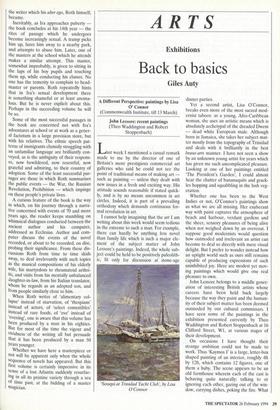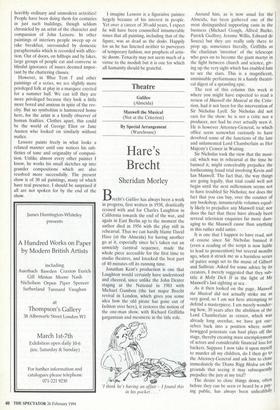ARTS
Exhibitions
Back to basics
Giles Auty
A Different Perspective: paintings by Lisa 0' Connor (Commonwealth Institute, till 13 March) John Lessore: recent paintings (Theo Waddington and Robert Stoppenbach) Last week I mentioned a casual remark made to me by the director of one of Britain's more prestigious commercial art galleries who said he could not see the point of traditional means of making art — such as painting — unless they dealt with new issues in a fresh and exciting way. His attitude sounds reasonable if stated quick- ly, and is by no means uncommon in art circles. Indeed, it is part of a prevailing orthodoxy which demands continuous for- mal revolution in art.
I cannot help imagining that the art I am writing about this week would seem tedious in the extreme to such a man. For example, there can hardly be anything less novel than family life which is such a major ele- ment of the subject matter of John Lessore's paintings. Indeed, the whole sub- ject could be held to be positively paleolith- ic, fit only for discussion at stone-age dinner parties.
Yet a second artist, Lisa O'Connor, breaks even more of the most sacred mod- ernist taboos: as a young, Afro-Caribbean woman, she uses an artistic means which is absolutely archetypal of the dreaded Dwem — dead white European male. Although born in Jamaica, she takes her subject mat- ter mostly from the topography of Trinidad and deals with it brilliantly in the best beaux-arts manner. I have not seen a show by an unknown young artist for years which has given me such uncomplicated pleasure.
Looking at one of her paintings entitled 'The President's Garden', I could almost hear the chatter of bananaquits and grack- les hopping and squabbling in the lush veg- etation.
Whether one has been to the West Indies or not, O'Connor's paintings show us what we are all missing. Her exuberant way with paint captures the atmosphere of beach and harbour, verdant gardens and the sheer, sensory pleasures of being alive when not weighed down by an overcoat. I suppose good modernists would question how outmoded and irrelevant an artist can become to deal so directly with mere visual delight. But I prefer to wonder instead how an uptight world such as ours still remains capable of producing expressions of such uninhibited joy. Here are modest yet mov- ing paintings which would give one real pleasure to own.
John Lessore belongs to a middle gener- ation of interesting British artists whose careers have been held back largely because the way they paint and the human- ity of their subject matter has been deemed outmoded by our cultural commissars. I have seen some of the paintings in the exhibition presented currently by Theo Waddington and Robert Stoppenbach at 16 Clifford Street, WI, at various stages of their development.
On occasions I have thought their strange ambition could not be made to work. Thus `Kaymos I' is a large, letter-box shaped painting of an interior, roughly 4ft by 12ft, which contains 12 figures, one of them a baby. The scene appears to be an old farmhouse wherein each of the cast is behaving quite naturally: talking to or ignoring each other, gazing out of the win- dow, carrying dishes, poking the fire. What horribly ordinary and unmodern activities! People have been doing them for centuries in just such buildings, though seldom chronicled by an artist of the character and compassion of John Lessore. In other paintings of interiors people sweep up or take breakfast, surrounded by domestic paraphernalia which is recorded with affec- tion. Out of doors, on hilltops and by lakes, large groups of people eat and converse in blissful ignorance of issues deemed impor- tant by the chattering classes.
However, in 'Blue Tent I' and other paintings of a series, we see slightly more privileged folk at play in a marquee erected for a summer ball. We can tell they are more privileged because they look a little more bored and anxious in spite of the rev- elry. But no symbolism is hammered home here, for the artist is a kindly observer of human frailties. Clothes apart, this could be the world of George Eliot or Jane Austen who looked on similarly without malice.
Lessore paints freely in what looks a relaxed manner until one notices his sub- tleties of tone and originality of composi- tion. Unlike almost every other painter I know, he works his small sketches up into grander compositions which are also resolved more successfully. The present show is of 30 oil paintings, many of which have real presence. I should be surprised if all are not spoken for by the end of the show. I imagine Lessore is a figurative painter largely because of his interest in people. Yet over a career of 30-odd years, I expect he will have been counselled innumerable times that all painting, including that of the figure, was as dead as the dodo. Happily for us he has listened neither to purveyors of temporary fashion, nor prophets of artis- tic doom. Tenacity may not seem much of a virtue to the modish but it is one for which all humanity should be grateful.



























































 Previous page
Previous page